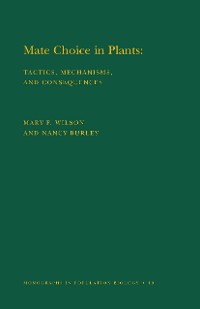Mate Choice in Plants
Mary F. Willson, Nancy Burley
Naturwissenschaften, Medizin, Informatik, Technik / ÷kologie
Beschreibung
This book maintains that higher plants manifest some degree of sexual selection, and it begins to build a framework that unifies many features of plant reproduction previously considered unrelated. Reviewing evidence for sexual selection in plants, the authors discuss possible male-female interactions, concluding with an extensive set of hypotheses for testing.
Mechanisms that could be employed in sexual selection in plants include various cellular mechanisms, such as both nuclear and cytoplasmic genetics, B chromosomes, and paternal contributions to the zygote, as well as abortion, double fertilization, delayed fertilization, and certain forms of polyembryony. This study compares the consequences of these processes for the evolution of mate choice in "gymnosperms" and angiosperms.
Kundenbewertungen
Gamete, Seed predation, Kin selection, Maternal effect, Plant reproductive morphology, Coefficient of relationship, Natural selection, Directional selection, Inbreeding, Regulation of gene expression, Gene flow, Loranthaceae, Microspore, Endosperm, Meiosis, Gymnosperm, Evolution of sexual reproduction, Gametophyte, Ovule, Drosophila melanogaster, Pollination, Genotype, Mother plant, Pollen source, Zygote, B chromosome, Population genetics, Embryo quality, Reproduction, Mating, Parental investment, Segregate (taxonomy), Allele, Pollen tube, Scrophulariaceae, Chiasma (genetics), Reproductive system, Adaptation and Natural Selection, Sexual selection, Asexual reproduction, Flowering plant, Meiotic drive, Plant reproduction, Parthenogenesis, Fertilisation, Double fertilization, Reproductive value (population genetics), Female, Honey bee, Sex ratio, Hamamelidaceae, Polymorphism (biology), Mate choice, Group selection, Hybrid (biology), Embryo, Outcrossing, Pollinator, Reproductive success, Selfing, Sexual dimorphism, Sporophyte, Marchantiophyta, Transplant experiment, Spermatophyte, Sperm, Sexual reproduction, Western honey bee, Pollen, Liriodendron tulipifera


























